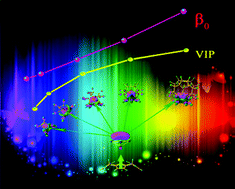A new strategy for simultaneously enhancing nonlinear optical response and electron stability in novel cup–saucer+–cage−-shaped sandwich electride molecules with an excess electron protected inside the cage
Abstract
Novel cup–saucer–cage-shaped sandwich electride molecules calix[4]pyrrole⋯K3O+⋯e@CnFn−, (n = 8, 10, 14, 20, and 36) with an excess electron protected inside the CnFn cage are constructed theoretically. In the sandwich structures, the below calix[4]pyrrole cup pushes the valence electron of the sandwiched superalkali atom K3O saucer, forming an excess electron, which is further pulled and protected inside the above CnFn cage, thus an electron-transfer relay occurs. In particular, owing to the unusual electron transfer, an unusual and fortunate phenomenon is discovered that increasing the CnFn cage size enhances not only the nonlinear optical response (β0), but also the electron stability (VIP). Thus, a new strategy of simultaneously enhancing β0 and VIP values is found for the first time, namely by increasing the CnFn cage size in novel cup–saucer–cage-shaped sandwich electride molecules, with the excess electron protected inside the cage.


 Please wait while we load your content...
Please wait while we load your content...